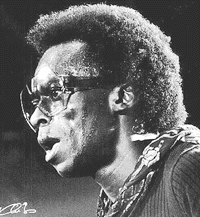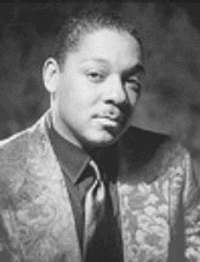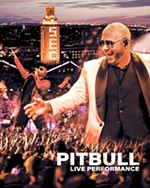Some of That Jazz
Compared to What?
By Harvey Pekar, Fri., Feb. 20, 1998
|
|
Unfortunately, both authors ignore the gifted innovators who've emerged in the 1980s and 90s. Therefore their books leave much to be desired, as neither deals with avant-gardists Joe Maneri, John Zorn, Dave Douglas, and Don Byron, who, among many others in the "new music" movement are determining the direction in which American improvised music will evolve.
What Jazz Is seems aimed at people who don't know much about the music. It's a pretty decent book as far as it goes, but that's not very far. King divides it into several sections during which he describes jazz in general, the roles of specific instruments, and analyzes recorded performances in easy-to-comprehend terms. However, he concentrates on the 1950s and Sixties far more than earlier decades, giving the music before them short shrift and, in terms of younger musicians, pretty much concentrating on the young lions, who have no use for creativity and originality. Dewey Redman played with avant-gardists Ornette Coleman and Keith Jarrett in the 1960s and Seventies while his son Joshua imitates Fifties bop and post-bop tenormen like Sonny Rollins and Sonny Stitt, who were at their best before he was born.
King is amiable and non-judgmental to the point that he doesn't make a distinction between imitators and innovators. The young lions aren't creative mainstream musicians like Hank Mobley and Sonny Clark, who, while not major innovators, did contribute to the post-bop vocabulary while it was being formed in the Fifties. Decades later, the young lions came along, appropriated this vocabulary, and yet were treated by large media outlets as if they'd invented it. The position of the technically proficient but imitative young lions in the Nineties is similar to that of the Dixieland revivalists in the Forties, when Dixieland was popular and the music of great, forward-looking musicians like Thelonious Monk and Charlie Parker was being ridiculed.
Blue: The Murder of Jazz by Eric Nisenson (St. Martin's Press, $22.95 hard) examines the young lions phenomenon in general and focuses particularly on the inordinate attention given to Marsalis and the extraordinary amount of power he's been able to accumulate. What Nisenson says about this is valid and important; however his knowledge of music from a technical standpoint is shaky. He makes mistakes which, though they do not undermine his basic ideas, will cause some readers to doubt his credibility and give aid and comfort to those who oppose his views.
He correctly points out that the greatest artists have always been innovators, so that Miles Davis and Duke Ellington are immeasurably more important aesthetically than Marsalis, who has derived plenty from both. Some of Marsalis' less fanatic admirers would probably agree with this, but claim that at least he is attracting listeners to jazz who would otherwise be indifferent to it.
Nisenson points out, however, that jazz is getting less and less radio air time and that its share of total albums sold has slipped from 5% prior to Marsalis' rise to a current 3%. Even Marsalis' record sales these days are nothing to write home about. He certainly hasn't chased lite jazz practitioners like Kenny G. out of the market place, and, in fact, does not rival him in popularity.
Marsalis shouldn't be blamed for declining jazz record sales, but he hasn't done anything to improve them or attract large numbers of listeners to the music, although his personal income is healthy, he still gets plenty of media attention and has a great deal of power as artistic director of the Lincoln Center jazz program.
The way he uses his power particularly disturbs Nisenson. Influenced by writers Stanley Crouch and Albert Murray, Marsalis developed a narrow definition of jazz, which he claimed had to swing and have a strong blues feeling. This was at a time when some jazz experimenters, who could swing easily when they desired, chose not to on certain occasions because they felt that their music would be more rhythmically interesting if they avoided stock devices associated with swinging. Interestingly, though the music of New Orleans jazzmen prior to Louis Armstrong's impact, including Kid Ory and Freddie Keppard, swung very little, if at all, Marsalis praised them. The people he attacked were non-swinging avant-gardists.
Marsalis preached to everyone from elementary school students to national TV audiences about what he thought jazz was and wasn't, and employed a programming policy at Lincoln Center that raised a good deal of controversy. Writes Nisenson, "...what does bother me and many others about the Lincoln Center program is that while having focused on jazz players ranging from the greatest innovators to far lesser talents, except for one token concert (focusing on the late Gerry Mulligan) it has not saluted any white musicians. Does Marsalis really believe that, say, Dewey Redman - who was saluted in a Lincoln Center concert - is of greater historical importance than Bix (Beiderbecke) or (Benny) Goodman or Bill Evans?"
One of the better chapters in Blue contains a refutation by Nisenson of the attacks leveled by traditionalists on fusion, which they view as tainted by electric instruments and rock & roll and R&B influences. Plenty of bad fusion records have been cut, but plenty of bad acoustic albums have as well. To dismiss music that employs heavily amplified guitars and electronic keyboard instruments is absurd. Miles Davis had great fusion bands. Weather Report and Tony Williams' Lifetime with Larry Young and John McLaughlin were impressive as well. If the Lincoln Center crowd wants to badmouth people, why don't they start with Lionel Hampton, Eddie Durham, Floyd Smith, Charlie Christian, and Fats Waller, who pioneered the use of electric instruments in the Thirties and early Forties?
|
|
Nisenson sees the damage that Marsalis is doing and levels many well-founded criticisms at him. However, he also makes some near ludicrous statements in the process of discussing and describing jazz. For example, he writes that Lester Young was a precursor of Ornette Coleman because "...to Young the creation of melody was everything and harmony was at best a secondary consideration." But Nisenson overlooks some important details in this connection. Coleman's great contribution was refusing to base his solos on pre-set chord progressions. Young's solos were based on chord progressions. The fact that Young and Coleman both played spare, song-like solos doesn't mean Young necessarily forecast Coleman's work. Young wasn't the first or only jazzman to play in this manner. Moreover, Coleman sometimes played violent flurries of notes more like Coleman Hawkins, Charlie Parker, or John Coltrane than Young. And Young was not as uninterested in harmony as Nisenson thinks; in fact his unusual selection of notes contributed to the melodic freshness of his solos. To say that Young anticipated Coleman or was the original discoverer of "harmolodics" means nothing and may cause some readers to dismiss Nisenson.
At another point Nisenson describes Mark Whitfield's compositions as "not much more than a series of chords with only a very thin melody connecting them." Melodies aren't thick or thin. Maybe Nisenson means that Whitfield writes uninteresting, poorly thought out, cliché-ridden melodies. It's really not a big deal, but again Nisenson leaves himself open to the charge that he doesn't know what he's talking about.
The reactionary movement Marsalis began had its start around 1980 as a result of the exhaustion of the free-jazz movement. Free-jazzmen theoretically accepted no pre-set limitations, such as chord progressions, on their choice of notes. Although some great free-jazz was performed, many free-jazzmen were handicapped by the lack of a foundation on which to build their improvised work. Their choice of notes was limited, in fact, by their lack of knowledge and/or imagination and was frequently monotonous, as they substituted honking and screaming with their instruments for playing creatively. By about 1970, some free-jazzmen - Anthony Braxton, Henry Threadgill - were placing renewed emphasis on structuring their work. By 1980 it became obvious that structure needed to be reemphasized. Some musicians, e.g. Zorn, created new forms and structures while others, such as Marsalis, simply returned to the music of earlier decades. Wynton was lucky in several ways. More people could follow, and thus patronize, the kind of music he played in 1985 than in 1955-65. He gained a great deal of credibility because he was an excellent classical trumpeter, though this had nothing to do with his ability to improvise creatively. And Columbia Records spent a great deal of money hyping him.
Currently the major creative musicians are those in the "new music" movement. They have a working knowledge of various forms of music, classical, rock, R&B, Balkan, Near Eastern, Indian, in addition to jazz, and are synthesizing them in various ways, creating music so fresh and unique that they've launched a golden age. Although some, such as Byron, are African-American, most are white. Perhaps this has contributed to the racial discord. For the first time African-Americans, such as Marsalis, are leading a reactionary jazz movement. "New music" has definitely evolved from jazz. Whether Marsalis and Crouch want to classify it as jazz doesn't matter; what's important is that it is exciting, innovative, high-quality art. There have been some critics who claimed that only Dixieland was true jazz. So what?
What Marsalis and the young lions are doing now is comparable to what classical musicians do when they play the works of Bach and Beethoven. They may interpret the works of these composers well, but that's all they're doing. Similarly, the young lions may do a good job of putting the licks of earlier jazz musicians together, but they should not be given credit for inventing them.










